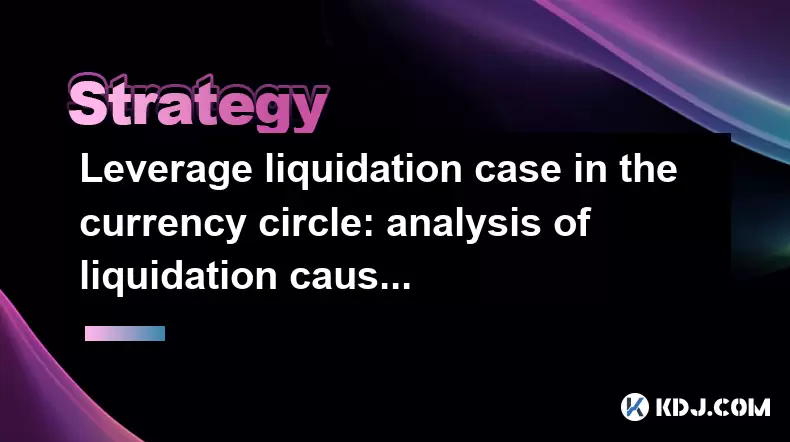-
 bitcoin
bitcoin $114320.977035 USD
-0.40% -
 ethereum
ethereum $4152.439985 USD
-1.75% -
 tether
tether $1.000111 USD
-0.04% -
 xrp
xrp $2.843037 USD
-1.63% -
 bnb
bnb $1013.349380 USD
-1.62% -
 solana
solana $208.362767 USD
-2.10% -
 usd-coin
usd-coin $0.999783 USD
0.00% -
 dogecoin
dogecoin $0.232559 USD
-1.00% -
 tron
tron $0.333491 USD
-1.09% -
 cardano
cardano $0.806310 USD
0.19% -
 hyperliquid
hyperliquid $45.023720 USD
-1.59% -
 ethena-usde
ethena-usde $1.000819 USD
-0.06% -
 chainlink
chainlink $21.241249 USD
-2.11% -
 avalanche
avalanche $30.035416 USD
-0.66% -
 stellar
stellar $0.364984 USD
-2.05%
Leverage liquidation case in the currency circle: analysis of liquidation causes and experience summary
Leverage trading in crypto can amplify returns but also risks liquidation if market volatility or insufficient margin triggers a margin call traders can't meet.
Jun 13, 2025 at 07:28 am

In the cryptocurrency trading world, leverage trading is a popular method that allows traders to amplify their potential returns. However, with high rewards come high risks, one of which is leverage liquidation. This article delves into the causes of leverage liquidation in the cryptocurrency market and provides a comprehensive summary of experiences to help traders navigate these risky waters.
Understanding Leverage and Liquidation
Leverage trading involves borrowing funds to increase the size of a trade. In the context of cryptocurrency, traders can use leverage to increase their exposure to a particular asset without committing the full amount of capital. However, if the market moves against a leveraged position, the trader may face a margin call, which requires additional funds to be deposited to maintain the position. If the trader cannot meet the margin call, the position is liquidated to prevent further losses.
Liquidation occurs when a trader's position is forcibly closed by the exchange due to insufficient funds to cover potential losses. This happens when the value of the collateral falls below a certain threshold, known as the liquidation price. Understanding the mechanics of leverage and the concept of liquidation is crucial for any trader engaging in leveraged trading.
Common Causes of Leverage Liquidation
Several factors can lead to leverage liquidation in the cryptocurrency market. Here are some of the most common causes:
Market Volatility: Cryptocurrency markets are known for their high volatility. Sudden price swings can quickly push a leveraged position into the red, triggering a margin call and subsequent liquidation if the trader cannot add more funds.
Insufficient Margin: Traders often underestimate the amount of margin required to maintain their positions. If the market moves against them, they may find themselves unable to meet the margin call, leading to liquidation.
Leverage Ratio: Using a high leverage ratio increases the risk of liquidation. While higher leverage can amplify gains, it also amplifies losses, making positions more susceptible to liquidation.
Lack of Stop-Loss Orders: Failing to set stop-loss orders can lead to significant losses. A stop-loss order automatically closes a position when it reaches a certain loss threshold, potentially preventing liquidation.
Technical Issues: Sometimes, technical issues such as platform downtime or slow transaction processing can prevent traders from adding funds in time to meet a margin call, resulting in liquidation.
Case Study: A Real-Life Example of Leverage Liquidation
To illustrate the risks of leverage trading, let's examine a hypothetical case study. Imagine a trader, Alice, who decides to trade Bitcoin with 10x leverage. She opens a long position with a notional value of $10,000, using only $1,000 of her own capital. The rest is borrowed from the exchange.
Initial Setup: Alice's position is initially profitable as Bitcoin's price rises. However, the market suddenly reverses, and Bitcoin's price drops sharply.
Margin Call: As the price continues to fall, Alice receives a margin call. She needs to deposit additional funds to maintain her position, but she doesn't have enough available cash.
Liquidation: Unable to meet the margin call, Alice's position is liquidated. She loses her entire $1,000 investment, and the borrowed funds are repaid to the exchange.
This case study highlights the importance of understanding the risks associated with leverage trading and the need for careful risk management.
Strategies to Prevent Leverage Liquidation
To minimize the risk of leverage liquidation, traders can employ several strategies:
Use Lower Leverage: Opting for lower leverage ratios can reduce the risk of liquidation. While the potential gains may be smaller, the risk of significant losses is also lower.
Set Stop-Loss Orders: Always set stop-loss orders to automatically close positions if they reach a certain loss threshold. This can help limit losses and prevent liquidation.
Monitor Positions Closely: Keep a close eye on market movements and your positions. Being proactive can help you respond quickly to margin calls and add funds if necessary.
Maintain Adequate Margin: Ensure you have sufficient funds in your account to cover potential margin calls. This may mean keeping a portion of your capital as a buffer.
Diversify Your Portfolio: Spreading your investments across different assets can reduce the impact of a single position being liquidated.
Learning from Liquidation Experiences
Traders who have experienced leverage liquidation often gain valuable insights that can help them avoid similar situations in the future. Here are some key lessons learned from those who have been through liquidation:
Emotional Discipline: Many traders cite emotional decision-making as a significant factor in their liquidations. Maintaining emotional discipline and sticking to a trading plan can help prevent rash decisions that lead to liquidation.
Risk Management: Effective risk management is crucial. This includes setting appropriate leverage levels, using stop-loss orders, and diversifying your portfolio.
Continuous Learning: The cryptocurrency market is constantly evolving. Staying informed about market trends, new trading tools, and strategies can help traders make more informed decisions and avoid liquidation.
Realistic Expectations: Setting realistic expectations about potential gains and losses can help traders avoid over-leveraging their positions. Understanding that losses are part of trading can lead to more balanced and sustainable trading practices.
Frequently Asked Questions
Q: Can leverage liquidation be avoided entirely?A: While it's impossible to avoid leverage liquidation entirely due to the inherent risks of trading, traders can significantly reduce the likelihood of liquidation by employing effective risk management strategies, such as using lower leverage, setting stop-loss orders, and maintaining adequate margin.
Q: What happens to the borrowed funds after a liquidation?A: After a liquidation, the borrowed funds are repaid to the exchange. Any remaining funds in the trader's account, after covering the losses and fees, are returned to the trader. If the losses exceed the trader's collateral, the trader may owe additional funds to the exchange.
Q: Is it possible to recover from a leverage liquidation?A: Yes, it is possible to recover from a leverage liquidation. Traders can learn from their experiences, adjust their trading strategies, and continue trading. However, it's important to approach trading with a clear plan and realistic expectations to avoid repeating past mistakes.
Q: How does the choice of trading platform affect the risk of leverage liquidation?A: The choice of trading platform can significantly impact the risk of leverage liquidation. Different platforms have varying margin requirements, liquidation policies, and technical reliability. Choosing a reputable platform with transparent policies and robust infrastructure can help minimize the risk of liquidation due to technical issues or unclear rules.
Disclaimer:info@kdj.com
The information provided is not trading advice. kdj.com does not assume any responsibility for any investments made based on the information provided in this article. Cryptocurrencies are highly volatile and it is highly recommended that you invest with caution after thorough research!
If you believe that the content used on this website infringes your copyright, please contact us immediately (info@kdj.com) and we will delete it promptly.
- BlockDAG, DOGE, HYPE Sponsorship: Crypto Trends Shaping 2025
- 2025-10-01 00:25:13
- Deutsche Börse and Circle: A StableCoin Adoption Powerhouse in Europe
- 2025-10-01 00:25:13
- BlockDAG's Presale Buzz: Is It the Crypto to Watch in October 2025?
- 2025-10-01 00:30:13
- Bitcoin, Crypto, and IQ: When Genius Meets Digital Gold?
- 2025-10-01 00:30:13
- Stablecoins, American Innovation, and Wallet Tokens: The Next Frontier
- 2025-10-01 00:35:12
- NBU, Coins, and Crypto in Ukraine: A New Yorker's Take
- 2025-10-01 00:45:14
Related knowledge

Practical parameter settings for a Bitcoin multi-timeframe moving average system
Sep 18,2025 at 10:54pm
Optimizing Timeframe Combinations for Bitcoin Trading1. Selecting appropriate timeframes is crucial when building a multi-timeframe moving average sys...

How can I filter out false breakouts in Dogecoin high-frequency trading?
Sep 22,2025 at 01:00am
Understanding False Breakouts in Dogecoin Trading1. A false breakout occurs when Dogecoin's price appears to move beyond a defined support or resistan...

Techniques for identifying tops and bottoms in the Bitcoin on-chain NVT model
Sep 20,2025 at 07:54pm
Understanding the NVT Model in Bitcoin Analysis1. The Network Value to Transactions (NVT) ratio is often described as the 'P/E ratio' of the cryptocur...

What does the surge in open interest in Bitcoincoin futures mean?
Sep 20,2025 at 11:18pm
Understanding the Surge in Dogecoin Futures Open Interest1. A surge in open interest within Dogecoin futures indicates a growing number of active cont...

How can I use the Ethereum USDT premium to gauge market sentiment?
Sep 18,2025 at 11:55pm
Understanding the Ethereum USDT Premium1. The Ethereum USDT premium refers to the price difference between USDT (Tether) traded on Ethereum-based plat...

What should I do if Ethereum staking yields decline?
Sep 20,2025 at 06:18am
Understanding the Causes Behind Declining Ethereum Staking Yields1. The Ethereum network transitioned to a proof-of-stake consensus mechanism with the...

Practical parameter settings for a Bitcoin multi-timeframe moving average system
Sep 18,2025 at 10:54pm
Optimizing Timeframe Combinations for Bitcoin Trading1. Selecting appropriate timeframes is crucial when building a multi-timeframe moving average sys...

How can I filter out false breakouts in Dogecoin high-frequency trading?
Sep 22,2025 at 01:00am
Understanding False Breakouts in Dogecoin Trading1. A false breakout occurs when Dogecoin's price appears to move beyond a defined support or resistan...

Techniques for identifying tops and bottoms in the Bitcoin on-chain NVT model
Sep 20,2025 at 07:54pm
Understanding the NVT Model in Bitcoin Analysis1. The Network Value to Transactions (NVT) ratio is often described as the 'P/E ratio' of the cryptocur...

What does the surge in open interest in Bitcoincoin futures mean?
Sep 20,2025 at 11:18pm
Understanding the Surge in Dogecoin Futures Open Interest1. A surge in open interest within Dogecoin futures indicates a growing number of active cont...

How can I use the Ethereum USDT premium to gauge market sentiment?
Sep 18,2025 at 11:55pm
Understanding the Ethereum USDT Premium1. The Ethereum USDT premium refers to the price difference between USDT (Tether) traded on Ethereum-based plat...

What should I do if Ethereum staking yields decline?
Sep 20,2025 at 06:18am
Understanding the Causes Behind Declining Ethereum Staking Yields1. The Ethereum network transitioned to a proof-of-stake consensus mechanism with the...
See all articles










































































